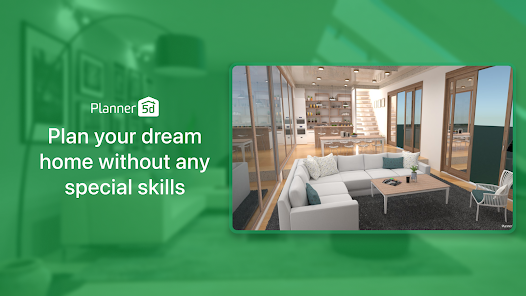Online services have the benefit of being accessible from any location and on any device, which is one advantage they offer over native apps. Yet, native programmes are more able to utilise a computer’s capabilities and are typically more responsive as a result. To have the best of both worlds, why not blend the two, though?
This is what the staff at Planner 5D(opens in new tab) have done: you can access the service using any online browser, making it available whenever and wherever you are. But, they also created native programmes for operating systems like Macintosh, Windows, Android, and iOS (versions 13 and up) (10.15 and above).
Your creations are therefore just a click away, whether you’re using your own or someone else’s device. This is a fantastic strategy, but how does the service perform as a whole? Let’s investigate.
To begin with, you can test it out without cost. In fact, you’re urged to do it. Naturally, there are restrictions, such as a small library and no access to high-quality digital representations, but you may test the system’s functionality and determine if it’s perfect for you.
You can choose between a blank canvas and a template by clicking on “Start Creating for Free” in your preferred browser(opens in new tab), but the moment you try to add something or change an existing item, you’re prompted to create an account. We would have preferred it if this phase hadn’t been concealed in such a manner. Nevertheless, setting one up is simple. You may do it by providing your email address or by creating an account with Apple, Google, or Facebook. The native apps we tried don’t seem to experience this (both on iOS and macOS).
The option to test out premium subscriptions for free for three days is another benefit of native apps. It won’t take long, but you should be able to tell if this is the best 3D design programme for you after that.
Building a home
Whichever platform you’re using, you have a choice between starting from scratch or a template. Mobile devices also allow you to ‘Capture Your Room’. Once you grant the app access to your camera, you can use it to create a virtual representation of the room you’re in, simply my moving your phone around, giving the app the data it needs (this is still labelled as a beta, so your mileage may vary).
Adding walls is easy and if you’re familiar with such design services, pretty intuitive. As you’d expect, each platform takes advantage of its respective strengths, but the process is pretty similar for all.
Inserting windows and doors is just a matter of choosing the type you wish to use and dragging it to its desired location. If it’s not exactly right, just select it and drag it to another place. You’ll find doors and windows ‘snap’ to existing walls, and when altering the walls themselves, they’ll automatically ‘snap’ at right angles to other walls.
Of course, this is where you’ll encounter some restrictions: you’ll be able to see all objects in the catalog, but those with a padlock top right of the thumbnail are only available to premium members – and that’s practically all of them, save a couple or so for each category. However, the number of categories is quite extensive, allowing you to go beyond the basics of a living room, kids’ room, kitchen or office, venturing to patios, swimming pools, even trees and bushes.
From what we could see, you can create a building with up to three floors.
Editing and customisation
Once you’ve built your home it’s time to decorate it. Let’s start with the walls and floors. There’s a lot of customisation options open to you. You can apply different materials to the inner and outer walls, or add carpet or laminate flooring, for instance. Modifying an object’s colour is also a possibility, which will be applied over the selected material and style. It’s all very simple and straightforward.
Such alterations can be performed whether you’re working in a top down 2D view (the default) or in 3D. Admittedly, it’s much easier to see what you’re doing when changing the look of the walls, floors and ceilings in 3D.
You won’t be able to add furniture in 3D though, or even alter the position and length of walls, nor the placement of doors and windows. All of this needs to happen in the 2D environment, and when it comes to customising furniture, you’ll find the online version has the advantage, at least when exploring the free side of the service: you’re able to edit the items you’ve added to your project. On the software side, this is treated as a premium service, but is somehow available through your web browser.
At least this allows you to see that pretty much every aspect of an object can be changed. Its length, width, height, even its elevation from the floor.
Premium
If you like how Planner 5D works, you might wish to grab yourself a subscription to gain access to additional features. The Premium Membership is split into two subscriptions. The first is Personal and will cost you £5 per month (billed yearly at £59.99). With it you’re able to use the entire catalog, are granted 60 renders and 60 textures, have access to academy courses, and can make use of Plan Recognition. This looks like a nifty feature, whereby you import a pre-designed plan, and Planner 5D will transform it into a 3D editable building for you. It even looks like it works with hand drawn plans as well.
The second subscription is called Commercial. It’s twice as expensive (£10/month, billed yearly at £119.99), and grants you all of the above, but doubles the number of renders and textures.
Whichever plan you’ve chosen, even the free one, should you need more photorealistic renders, they’re only a credit card number away (£7.99 for 20, up to £39.99 for 200). Quick snapshots are free.
Final verdict
Planner 5D is a well designed service. It works very well, whichever platform you’re using it on. It’s easy to use, and allows you to create projects very quickly. Selecting and editing objects is intuitive, and measurements are always on display when working in 2D, helping you remain accurate effortlessly. If you want full access to all features, including Plan Recognition, you’ll have to pay for the privilege, but there’s still enough there for free to full try out the service, or to satisfy the enthusiastic amateur.
Whichever level you’re at, it’s definitely worth taking a look.






